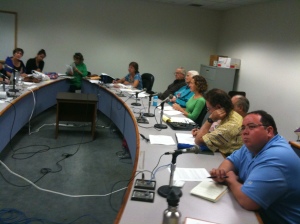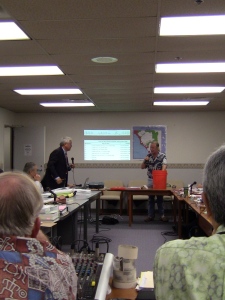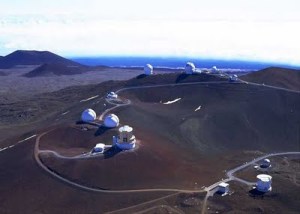 In the first week of the 2011 Legislative Session, the priorities for achieving a more sustainable future in Hawai‘i are already apparent. Ending Hawai‘i’s over-dependence on imported food and oil, as well as basic respect for indigenous knowledge and traditional practice as a component of environmental protection dominated the latest meeting of the Environmental Legislative Network (ELN).
In the first week of the 2011 Legislative Session, the priorities for achieving a more sustainable future in Hawai‘i are already apparent. Ending Hawai‘i’s over-dependence on imported food and oil, as well as basic respect for indigenous knowledge and traditional practice as a component of environmental protection dominated the latest meeting of the Environmental Legislative Network (ELN).
“The time is now to make fundamental changes,” said Marti Townsend at the ELN meeting. “This year Hawai‘i has a real opportunity to finally flip our dependence on imported food and energy and embrace culturally appropriate management paradigms.”
As the longstanding roundtable of Hawai‘i-based organizations involved in environmental policy, ELN convened this forum at the State Capitol to hear the priorities of more than 20 groups, citizens, and agencies tracking legislation this session. The Sierra Club and the Environmental Caucus of the Hawai‘i Democratic Party highlighted the need for a system to promote and encourage local agriculture.
The Hawai‘i Farmers Union and Hawai‘i School Garden Hui echoed the need for more agricultural education and resilience in Hawai‘i’s food systems. “Agriculture is alive in the hearts, minds, and hands of Hawai‘i’s youth who are experiencing nature through school gardens and other outdoor, applied learning opportunities,” said Hui member, Lydi Morgan Bernal. “They are the future farmers and pono stewards of our lands, waters, and communities.”
ELN members recognized that respect for indigenous knowledge, cultures and traditional practices is key to sustainable development and proper management of Hawai‘i’s environment. Accordingly, ELN members prioritized proposals that addressed fundamental concerns for the rights of Hawai‘i’s indigenous people.
The Office of Hawaiian Affairs identified three environmental priorities, including tightening of the requirements for the sale of state lands; establishing basic training for appointed officials on the rights of Native Hawaiians; and setting minimum requirements for all cultural impact assessments included in environmental impact statements or assessments.
“OHA is committed to safeguarding Hawai‘i’s land and cultural resources,” said Clyde Nāmu‘o, OHA’s chief executive officer. “This benefits Native Hawaiians and all of the people of Hawai‘i.”
In addition, groups at the ELN forum highlighted the need to continue support for land conservation funds and to find additional dedicated funding to address invasive species. “These funds and programs play a direct roll in protecting the state’s forests and fresh water supply, and prevent invasive species from doing further harm to our economy, environment and quality of life,” said The Nature Conservancy’s Mark Fox. “We ask the Legislature to continue to recognize that a healthy economy in the middle of the Pacific Ocean is dependent on a healthy environment.”
Also at the top of the list for legislative initiatives this session were: reducing plastic bags, improving invasive species controls, protecting endangered species, greater shoreline setbacks, and funding for the Climate Change Taskforce. All of the issues presented at the ELN forum are included in the attached summary of legislative priorities.
ELN members will be using the new Capitol Watch system as a method of tracking bills and resolutions throughout this legislative session. “We know the legislative process can be opaque to most people,” said Robert Harris of the Sierra Club. “The Capitol Watch is intended to demystify the process so people can follow their passion this legislative session.” The Capitol Watch system is open to the public and available at: http://www.sierraclubhawaii.com/capitol-watch.
______________________________
ELN Participants
Conservation Council for Hawai‘i
Environmental Caucus of the Hawai‘i Democratic Party
Friends of Lana‘i
Hanalei Watershed Hui
Hawai‘i Audubon Society
Hawai‘i Farmers Union
Hawai‘i School Garden Hui
Hawai‘i’s Thousand Friends
KAHEA: The Hawaiian-Environmental Alliance
Life of the Land
Livable Hawai‘i Kai Hui
My Organic Mom
Native Hawaiian Legal Corporation
Office of Hawaiian Affairs
PONO
Pono Aquaculture Alliance
Progressive Democrats
Sierra Club, Hawaii Chapter
Surfrider Foundation
The Green House Hawai‘i
The Nature Conservancy
Trust for Public Land
Voter-Owned Hawai‘i
Windward Ahupua‘a Alliance
See attached list “2011 Legislative Priorities,” Hawai‘i Environmental Legislative Network.
2011 Legislative Priorities
Hawai‘i Environmental Legislative Network
Conservation Council for Hawai‘i
Marjorie Ziegler, Director, http://www.conserveHI.org
1. Remove take restrictions on public hunting of game mammals. This modernizes the game program so that hunters can take more animals for food, and prevents the State from protecting these introduced animals at the expense of native Hawaiian species, essential watersheds, cultural sites, and agricultural lands.
2. Increase funding and identify permanent sources of funding for agricultural inspections at ports of entry and for invasive species control, research, and outreach on each island. Invasive species threaten public health, quality of life, the environment, the culture, watersheds, agriculture, and the economy.
3. Defend the Natural Area Reserve Fund, Land Conservation Fund, and Rental Housing Trust Fund against funding cuts and raids. These funds – supported by the conveyance tax – promote wildlife conservation, watershed protection, land acquisition in the public interest, and affordable housing.
Environmental Caucus of the Hawai‘i Democratic Party, Food Security and Sustainability Subcommittee, Juanita Kawamoto
1. Support establishment of a co-op livestock feed mill
2. Promote agricultural education through the development of school gardens and farms
3. Establish task force to better support farmers on agricultural leases
Environmental Caucus of the Hawai‘i Democratic Party, Energy and Climate Subcommittee, Charles Ice
1. Improve the Barrel Tax
2. Establish a Smart Grid
3. Encourage a better bicycle system
Environmental Caucus of the Hawai‘i Democratic Party, Natural Resources Subcommittee, William Sager
1. Improve Invasive Species Quarantine:
– Adequately fund the Invasive Species Committees rapid response teams.
– Resolution to improve quarantine inspection system that will minimize the introduction of alien pests, including joint federal-state inspection facilities at ports of entry like Honolulu International Airport and Honolulu Harbor.
2. Ban the use of plastic bags and Styrofoam food containers in Hawai‘i.
3. Establish a 2,000-foot conservation easement coastline setback on all state-owned lands on the Big Island.
Friends of Lana‘i
friendsoflanai@gmail.com, http://www.friendsoflanai.org
1. Reject any proposals that sidetrack or “streamline” the EIS process for any industrial power plant project. Considering the age, impatience and history of the Mainland developer for the proposed industrial wind power plant on Lana’i, it is very possible that Castle & Cooke, DBEDT and other state agencies, will try again to fast-track permit approvals, the EIS review process and/or other oversight provisions for renewable energy projects; e.g., DLNR attempting to change their conservation use district rules.
2. Insure that all public meetings with agendas that could impact Lana’i include at least one meeting on Lana’i. The recently announced list of public meetings for the DLNR’s review of conservation district rule changes includes visits to every island EXCEPT Lana’i.
3. Increase the number of Department of Conservation and Resource Enforcement (DOCARE) officers on Lana’i from one to three. It is impossible for one individual to effectively police this island of 90,000 acres.
Hanalei Watershed Hui
Maka‘ala Kauamoana, Executive Director
Defend and build the capacity of community-based stewardship programs to ensure long-term management of natural resources by those who rely on them most.
Hawai‘i School Garden Hui
http://hawaiischoolgardenhui.org
Form public-private partnerships to strengthen pre-kindergarten through post-secondary agricultural education and farm-to-school programs.
Hawai‘i’s Thousand Friends/League of Women Voters
http://www.Hawaiis1000friends.org
1. Ensure best possible mass transportation system for Oahu
2. Ensure system-wide improvements to the Honolulu Sewer System
KAHEA: The Hawaiian-Environmental Alliance
Marti Townsend, Program Director, http://www.kahea.org
1. Promote public access to the beach by establishing a “citizen suit provision,” which would allow individuals to enforce existing public access rights.
2. Encourage the development of sustainable food systems, including proper regulation of open ocean aquaculture and commercial fishing, strict limitations on genetic modification of food, and support for local farmers.
3. Prevent the weakening of Hawai‘i’s environmental review requirements (Haw. Rev. Stat. §343).
Life of the Land
Henry Curtis, Executive Director, http://www.LifeoftheLandHawaii.org
Improve transparency in public utility rates. After the Public Utilities Commission (PUC) has approved a power purchase contract, the cost figures should be made public. Ratepayers and taxpayers deserve to know how much different sources of electricity cost. Renewable energy companies would gain certainty understanding cost parameters.
My Organic Mom
Routh Bolomet, info@myorganicmom.com
1) Healthy Hawai‘i First act: A) Ban any chemical, food additive, ingredient, practice or procedure that will diminish the nutritional value or biological balance of our people’s health, threaten our food supply or resources that we use to grow our food in: water, air, soil. B) Regulate chemical trespass and chemical transformation due to Hawai‘i’s tradewinds and temperatures that exceed 76 degrees. Enforcement funded by fines and food import tax.
2) Sustainable Hawai‘i — Green Reward Incentive tax reduction programs: A) All new building permits must require new buildings or developments to be at least 75% self sustainable. All materials and systems brought into Hawaii must be reused or recycled without additional cost to the State or Counties. B) Upgrade State and County power generation infrastructure; C) Make these green systems available to the public for residential infrastructure reduction thru a mass purchasing facility (State Sustainability Depot).
3) Food Sustainability: A) Encourage backyard gardens — lessening the need to import food items and encouraging the consumption of food with higher nutritional values. B) Establish organic agricultural parks to support farmer success. Housing must be made available to the farming families on part of the land in a residential complex away from the fields. Funded by food import tax and 10% of food sales.
Native Hawaiian Legal Corporation
Alan Murakami, http://nhlchi.org
1. Establish a private attorney general right of action to impose penalties for violation of the burial protection laws and to clarify the breadth of available legal remedies to protect ancient Hawaiian burials from desecration by development.
2. Demand greater accountability for the production of homestead awards and begin to make adequate funding available to the DHHL, starting with an appropriation to pay for the installation of a water system to support pastoral homesteading at Honoka‘a.
3. Appointment of a cultural monitor to oversee and report on the implementation of programs to recognize and respect the ability of native Hawaiian prisoners in private prisons on the continent to observe religious/cultural practices while incarcerated without interference from prison officials.
Office of Hawaiian Affairs — Environmental Legislative Priorities
http://www.oha.org
1. Remedy the inconsistent quality of cultural impact assessments (CIAs) by codifying minimum requirements for assessing the impacts of a proposal on cultural practices; names OHA as the accepting authority for CIAs.
2. Require all council, board, and commission members that have an obligation to protect Native Hawaiian traditional and customary rights and related resources to attend a training course on their public trust responsibilities to Native Hawaiians.
3. Amendments to laws regulating the sale of state-controlled land to better enable decision-makers to assess the proposed sales and determine whether or not the lands were part of the public lands of the Kingdom of Hawai‘i or not.
PONO
Keiko Bonk, Director, http://www.oahurcd.org/pono
1. Pursue adequate state funding for the recovery of Hawai‘i’s 439 endangered species with focus on Hawai‘i State being out of compliance with ESA and MMPA laws for the critically endangered Hawaiian monk seal (ie. Gillnets and no required mitigation plan). Urgent need for funding for seal outreach and education for resident & visitor population.
2. Ban on Hawai‘i’s reef wildlife taking for sale by the international aquarium trade. Strong focus on endemic Hawaiian species for sale in this novelty industry.
Pono Aquaculture Alliance
http://www.ponoaqua.org
Encourage sustainable open ocean aquaculture by establishing minimum requirements for all open ocean aquaculture operations in state waters.
Sierra Club, Hawai‘i Chapter
Robert Harris, Executive Director, http://www.sierraclub.org/hawaii
1. Establish food sustainability standards that lay out Hawai‘i’s vision for the amount of local food it will produce and create metrics to determine our success in achieving these goals. Our state policy should encourage growing pono and eating ono.
2. Continue to reduce Hawai‘i’s opala (waste) addiction by reducing the number of paper and plastic bags sold, requiring recycling of CFL bulbs, and creating a mandatory “opt-in” requirement for the distribution of telephone books.
3. Require the use of native plants in public landscaping to ensure our government takes a leadership role in protecting indigenous plant species throughout Hawai‘i.
Surfrider Foundation
Stuart Coleman, surfrider.org/oahu
1. Ban single-use plastic bags (following the lead of Kauai and Maui) or establish a small fee for each single-use plastic or paper bag used to reduce the amount of waste going into our landfills and encourage people to use reusable bags;
2. Create a pilot program to promote water recycling and the re-use of gray water (from washers, showers and non-kitchen sinks) for 10% of Hawai‘i’s homeowners, saving money for individual owners and the counties by reducing the amount of water going into our wastewater treatment plants.
3. Create an initiative that offers qualified homeowners low-interest loans and/or tax incentives to upgrade from cesspools to septic tanks to reduce leaching sewage and water pollution, especially in rural and coastal lands.
4. Establish a 2000-foot shoreline setback on all Big Island state land from Ulupo Point to Volcanoes National Park to protect the historic Ala Kahakai Trail and preserve public access to the coast.
The Green House Hawai‘i
Betty Gearen and Gabriela Orante, info@thegreenhousehawaii.com
1. Reduce the environmental footprint of schools
2. Promote environmental education in schools.
The Nature Conservancy
Mark Fox, Legislative Coordinator, http://www.tnc.org
1. Defend the Natural Area Reserve Fund, Land Conservation Fund, and Rental Housing Trust Fund against funding cuts and raids. These funds – supported by the conveyance tax – promote wildlife conservation, watershed protection, land acquisition in the public interest, and affordable housing.
2. Increase funding and identify permanent sources of funding for agricultural inspections at ports of entry and for invasive species control, research, and outreach on each island. Invasive species threaten public health, quality of life, the environment, the culture, watersheds, agriculture, and the economy.
3. Support planning and resilience in our natural and constructed infrastructure to the effects of climate change. Ultimately, a small portion of the barrel fee (5-10%) should go to addressing the inevitable effects of climate change caused by burning fossil fuels. A good start would be to actually fund and organize the Climate Change Task Force created by the Legislature.
Trust for Public Land
Lea Hong, Executive Director, http://www.tpl.org
Defend the Natural Area Reserve Fund, Land Conservation Fund, and Rental Housing Trust Fund against funding cuts and raids. These funds – supported by the conveyance tax – promote wildlife conservation, watershed protection, land acquisition in the public interest, and affordable housing.
Voter Owned Hawai‘i: Working for Fair Elections
Kory Payne, Executive Director, http://www.voterownedhawaii.org
Support improvements to the outdated partial public funding program by supporting the Big Island public funding pilot program, which gives county council candidates the chance to qualify for a competitive amount of money to run for office.
Windward Ahupua‘a Alliance
Shannon Wood, Executive Director, http://www.waa-hawaii.org
1. Re-establish the CLIMATE CHANGE TASK FORCE – ACT 20 Special Session 2009 whose funding was never released by Governor Linda Lingle after her veto was over-ridden. Thus, its objectives – to identify current & potential impacts of global warming & sea level rise, to estimate the costs to mitigate damages caused by them & to suggest legislative & administrative policy changes primarily at county & state levels – were never carried out.
2. Create a temporary task force comprised of representatives from state & county public agencies, private sector businesses, non-governmental organizations, academic researchers, legal experts, and legislators to examine and evaluate Chapter 205 – Land Use Commission to identify sections which need legislative modifications reflecting 21st century social, cultural, environmental & economic shifts in policies & standards – especially section 205-17 – Land use commission decision-making criteria.
3. Establish a voluntary tax refund check-off fund ($3 to $5 per refund check) to provide additional financial support for the Natural Area Reserve Fund, the Land Conservation Fund, and Rental Housing Trust Fund. Hawai`i taxpayers already have set up similar check-offs for domestic violence programs, school repairs & maintenance, publicly-funded elections, and the state library system.
Read Full Post »






























